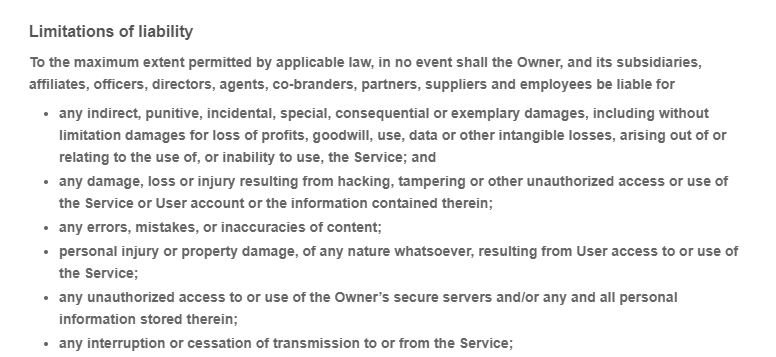A no-responsibility disclaimer is a specific type of disclaimer that helps individuals and businesses define what they are not liable for. In this post, we’ll explain what a no-responsibility disclaimer is, when you need one, and how to craft yours effectively. We’ll also provide examples to help you get started.

A no-responsibility disclaimer is a legal statement that informs your users that you are not liable for certain outcomes, actions or consequences. It is often used when things can potentially go wrong, in order to limit the liability of the business owner. That’s why you can find it in many different industries and platforms.
For example, let’s imagine you are a personal trainer who shares workout videos on YouTube. Your subscribers may follow your workouts and one of them could get injured as a result. A no-responsibility disclaimer can provide a good layer of protection here. In the description of your videos, you could add something like:
By performing these workouts, you do so at your own risk. By using this video, you agree that [your name] will not be held responsible for any injury you may suffer as a result of this workout video.
A no-responsibility disclaimer is often associated with a Limitation of Liability Clause that you can find in Terms and Conditions documents. This clause defines the conditions under which you may not be held liable.

There are many cases when you could need a no-responsibility disclaimer. Let’s examine the most common scenarios.
Sometimes websites or blogs publish content that, if misinterpreted, could possibly cause harm to users. For example, articles about health, legal, or financial matters could be read as the advice of a professional.
Websites like this often use a no-liability disclaimer to limit their liability and specify that, what is written on the website, does not constitute professional advice.
The information provided here is for general informational purposes only and is not intended as medical advice. Always consult with a qualified healthcare professional for personalized advice and treatment.
If your website or blog talks about:
then you may need to add a no-responsibility disclaimer!
Of course, this list is non-exhaustive and could include many more topics.
A no-responsibility disclaimer can apply to products and services as well. Businesses often use them to clarify that they are not liable for specific outcomes and that users assume a risk when using a product or service – especially when it’s not used properly.
The company is not liable for damages caused by improper use of this product.
A proper no-responsibility disclaimer can be difficult to write if you don’t have legal expertise. However, here are some tips that you can follow:
Now let’s take a look at the most common examples of no-responsibility disclaimers.
This disclaimer can be used both in the case of a product or software, when you want to limit your liability in case of improper use, or in the case of information that could be misinterpreted and possibly cause damage.
In the example below, Nanyang Technological University of Singapore limits its liability in relation to the information provided on the website.

This disclaimer is often used by bloggers, influencers, or businesses who write informational content but don’t want it to be taken as professional advice.
This content is for informational purposes only and does not constitute legal advice. I am not an attorney. Please consult a qualified professional for personalized advice.
For example, the disclaimer below is taken from one of our webinars. We often host webinars for our users, to help them have a better understanding of legal compliance. However, these webinars are not legal advice, they’re purely informative, so we make sure to specify that.

This type of disclaimer is often used for activities that involve some degree of risk, such as fitness classes or outdoor activities.
The example below is taken from the YouTube channel Lidia Mera, a pilates instructor who shares her workout videos.

Although a disclaimer can be a good starting point for limiting your liability, in some cases, it may be safer to have a more complete Terms and Conditions document.
For example, if your site handles complex scenarios like user account creation, or if you publish original copyrighted content. However, if you have an e-commerce site, Terms and Conditions aren’t just recommended, they’re mandatory because they contain information about the conditions of sale and disclosures on methods of payment, shipping, delivery, withdrawals, cancellation conditions, etc. – as required by consumer protection regulations.
Terms and Conditions are a legally binding document that helps you set the rules for your website or service. By requiring users to accept your Terms and Conditions, you ensure that they’ve agreed to your rules. They also cover a wider range of details than disclaimers.
With iubenda’s Terms and Conditions Generator, you can easily create your Terms and Conditions document.
Choose from our +100 pre-drafted clauses, translate your document into 15+ languages in just one click, and add it to your website by simply copying and pasting the code we provide.
The solution to draft, update and maintain your Terms and Conditions. Optimised for eCommerce, marketplace, SaaS, apps & more.